 So, how'd you spend your Bastille Day? You did celebrate Bastille Day, didn't you?
So, how'd you spend your Bastille Day? You did celebrate Bastille Day, didn't you?I made croissants that day. Croissants seemed like the perfect thing to make on the French national holiday because, like the French, they are a big pain in the butt to deal with.
What's that? Oh yes, I guess they are French too.
Click "Read More" for a recipe and more.
Croissants are basically a big slab of butter with dough wrapped around it which is rolled out and folded, rolled out and folded, then rolled out and folded again. The difficult part isn't the rolling or the folding: it is getting the temperature of the dough and the butter just right. You want them fairly cold, so that the dough is fairly stiff, but not so cold that the butter cracks.
From what I've read the ideal temperature for this is around 65 degrees. I didn't quite hit it right and just about gave up on making them (you'll notice a lack of photos of the cutting and the shaping... the dough was getting sticky and I thought I'd have to throw the whole thing in the garbage) but they came out quite good, so perhaps the recipe is more forgiving than it at first seems.
The recipe I used is from Bernard Clayton's New Complete Book of Breads. I prepared them over 3 days, with the butter step on the evening of the first day, the rolling on the second day, and the slicing, shaping, and baking on the third day.
Clayton recommends using a mix of cake flour and all-purpose flour. If you don't have any cake flour in the house you certainly can substitute in more all-purpose flour. You could even try whole wheat flour, if you are bold (Beth Hensberger has a whole wheat croissant recipe in her Bread Bible. I've never tried making them, so I can't tell you how they taste, but she swears they are good).
There are very few times that I think it really matters whether you use unsalted or salted butter, but there is so much butter in these that I suspect it would make a noticeable difference using salted butter. I wouldn't recommend using margarine either, but I have to admit that I've never tried it.
Croissants
Makes 20 to 30 pieces
1 1/2 cup unsalted butter, softened
3 tablespoons flour
Dough:
3 cups all-purpose unbleached flour
1 cup cake flour
2 teaspoons salt
2 tablespoons sugar
2 teaspoons instant yeast (or 1 packet instant or active dry yeast)
2 cups very warm milk (120-130 degrees)
Glaze:
1 egg plus 1 egg yoke and a pinch of salt
Combine the 3 tablespoons flour with the softened butter. Spread it out on aluminum foil to make a 6 to 8 inch square. Wrap the square in foil and refrigerate 2 to 3 hours or overnight.
Combine the flours and salt in a large bowl. Combine the warm milk, sugar, and yeast. Make a well in the flour, pour in wet ingredients, and stir them into the flour. Add additional flour or water as neccessary to make a soft dough (it will stiffen when chilled).
The dough should only be hand kneaded or mixed for 5 minutes or so to prevent the dough from toughening up. Cover the bowl with the dough and cool it in the refrigerator for at least an hour, until it is approximately 65 degrees (or place it in the refrigerator for longer and remove it to take the chill off before moving on to the next step).
Remove the butter and dough from the refrigerator and allow to warm until they are both around 65 degrees. At the proper temperature the dough will be fairly firm, the butter will be firm enough not to make your hands greasy when touching it but soft enough not to crack when bend.
(I've heard using a chilled marble work surface is a good way to keep the dough cool, but I don't have one so I didn't try it. If you have one though, it might be worth a shot.)
Stretch the dough out into a large square, roughly 10 inches per side.
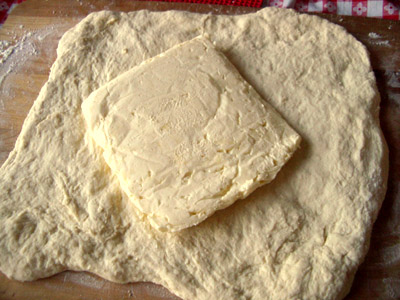
Place the block of butter on it diagonally and fold the corners of the dough over the butter, forming a large packet.
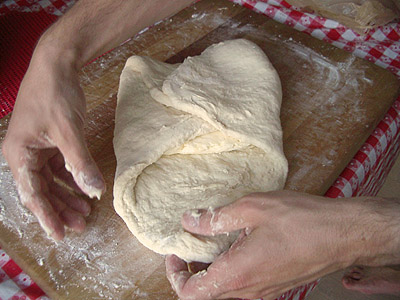
Roll the dough out into a long thin rectangle. Fold it in thirds like a letter, then rotate the dough 90 degrees and repeat this process.
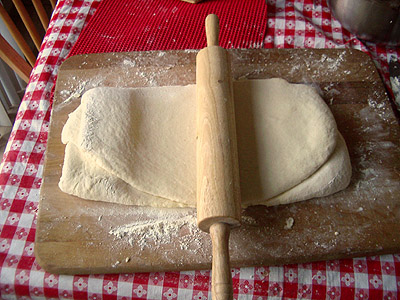
Wrap the package of dough in a cloth that has been soaked in cold water and wrung dry (I also placed this package in a plastic bag). Place the wrapped dough in the refrigerator for at least an hour.
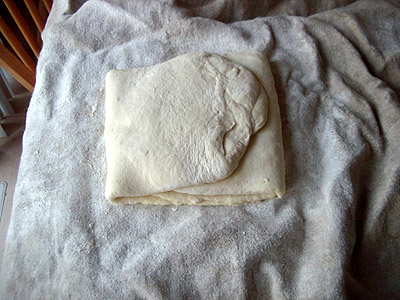
Unwrap the dough from the towel and roll it out and fold it a third time. Wrap it back in the towel and refrigerate it overnight.
The next morning, roll the dough out into a large rectangle. The dough should be extremely thin, approximately 1/8 inch thick. Cut the dough into a series of triangles, approximately 5 inches on each of the short sides and... quick... the third side is.... A squared + b squared = c squared... the square root of 50... just over 7 inches. (My high school geometry teacher would be so proud!)
Roll the triangles up from the long side toward the tip. Tuck the tip under the center and slightly stretch and curve the ends to make the crescent shape.
Place the croissants on a baking sheet and cover lightly with plastic wrap or wax paper. I just place the entire baking sheet in a clean garbage bag.
Set the croissants aside to rise until they've doubled in size, roughly 1 to 2 hours.
When they are close to risen, preheat the oven to 425. Remove the plastic from the baking sheets and gently glaze the croissants with the egg wash.
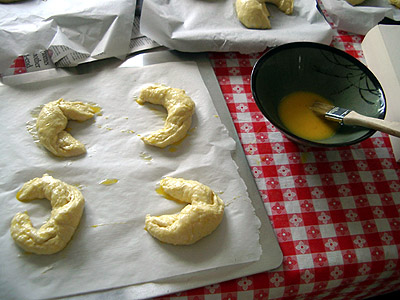
Bake the croissants for approximately 20 to 25 minutes. It is difficult not to burn them: because they contain so much fat they basically fry themselves when they get hot. I was surprised to find that the ones that came out most evenly browned but not burnt were the ones I baked on the double layer cookie sheet (shown in picture above) on the middle rack. They came out even better than the ones I baked on a standard baking sheet on the top rack. So watch them carefully, and adjust their location in the oven as necessary.
Croissants freeze very well. To reheat them, simply remove them from the freezer and place them in a toaster oven for 5 minutes. Good as new!
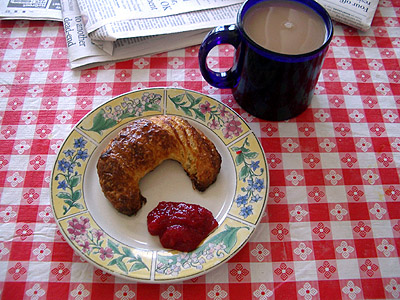
Advice on how to make croissants? Please share your experiences by adding comments below.
Comments
Mine aren't looking as nice as yours but they were still very tasty, I made them with white spelt flour and gluten free cake flour.
Thanks for the recipe.
Janice